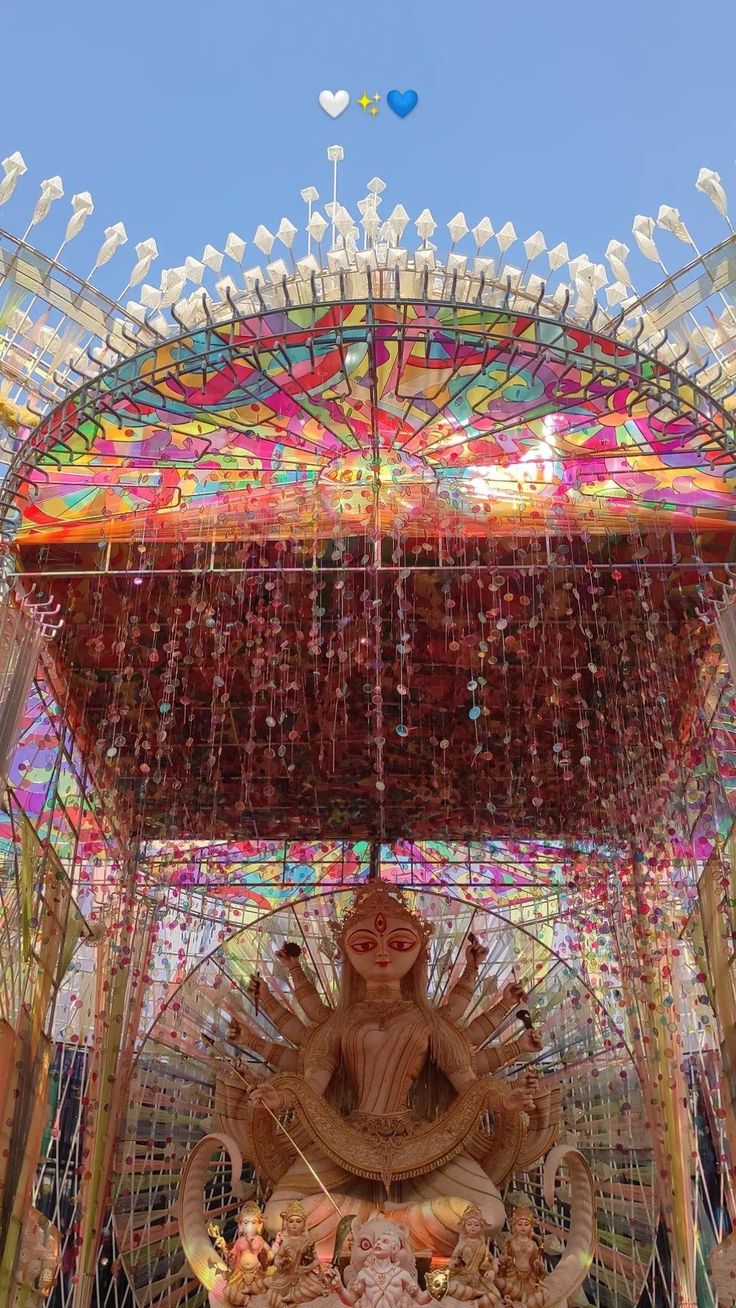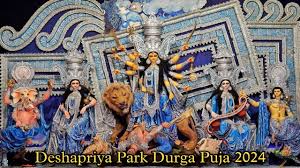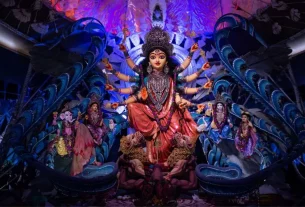Kolkata’s vibrant Durga Puja scene in 2024 brought forth a breathtaking masterpiece in the southern precincts of the city: Tridhara Sammilani’s Durga Puja at Deshapriya Park. In its monumental 78th edition, the club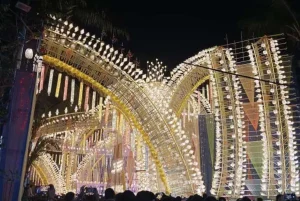 presented the theme “Prangan”, translating to “The Courtyard”—a concept deeply steeped in memory, community, and artistic expression.
presented the theme “Prangan”, translating to “The Courtyard”—a concept deeply steeped in memory, community, and artistic expression.
This blog delves into the rich tapestry of heritage aesthetics, cultural symbolism, and modern engagement that made Tridhara’s Prangan one of the most talked-about pandals of the year.
The Courtyard Theme: A Portal to Kolkata’s Soul
Prangan, the concept, symbolized more than an architectural element—it embodied the emotional epicenter of countless Bengali homes. The courtyard has always been a space where domestic rituals, informal gatherings, and cultural transmission took place. Tridhara’s pandal recreated that intimate atmosphere, transforming a public festive space into a shared living room of memories and tradition.
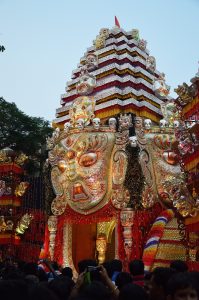 With this theme, the organizers invited visitors to step into a living Courtyard of Bengali life, where every decor piece told a story—of familial warmth, fading traditions, and the evolving pulse of city communities.
With this theme, the organizers invited visitors to step into a living Courtyard of Bengali life, where every decor piece told a story—of familial warmth, fading traditions, and the evolving pulse of city communities.
Visual Harmony: Artistic Language Meets Nostalgic Spirit
The visual narrative of Prangan unfolded in layers:
-
Traditional facades and frames evoked the grace of ancestral homes—arched doorways, clay patterns, aged brick textures, and classic alpona art adorned the entrance.
-
Ambient lighting—in warm ochre and soft ivory—created a soothing, welcoming glow, replicating dusk in an old family courtyard.
-
Interior motifs—pictured in the images above—brought out scenes of old Kolkata traditions: kids playing near potted plants, women in sarees lighting diyas, and ensuring an authentic family feel.
The simplicity of the elements combined with their emotive richness exemplified a key power keyword: nostalgic minimalism—art that feels deeply familiar yet speaks with refined artistry.
The Idol: Durga as Dweller of the Courtyard
The Goddess Durga stood at the heart of this courtyard—not as a distant deity but as a familial presence. Her idol was designed with graceful poise and modest ornamentation, reflecting the beauty found in everyday simplicity.
Her posture and expression mirrored the calm authority of a matriarch—she wasn’t secluded behind grandeur, but present in the hearth center, guarding her household with silent strength. It was a profound reminder that the divine resides in ordinary spaces and familiar routines.
Cultural Expressions: Live Traditions in a Public Courtyard
Tridhara’s cultural programming embraced the courtyard concept through:
-
Storytelling recitals in Bengali and English, capturing tales from village life, old weddings, and childhood games—all performed in a courtyard-like setup inside the pandal.
-
Musical sessions featuring lighter folk tunes—baul songs, traditional devotional melodies, and evening kirtans—reinforced the thematic idea of gathering and cultural sharing in home spaces.
-
Interactive spaces where children and elders engaged in sketching, alpona design, and mock clay pot
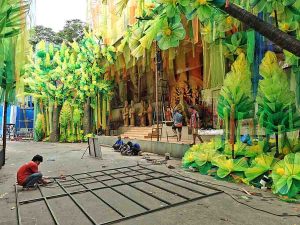
oplus_262144 painting evoked both engagement and remembrance.
This brought the courtyard to life—not just as a physical structure, but as a cultural exchange space.
Tradition Meets Modernity: A Blended Narrative
Tridhara’s Prangan was an eloquent fusion of cultural memory and contemporary artistry. Power keywords that capture this blend:
-
Heritage Revival: By bringing back courtyard imagery, the pandal resurrected a fading architectural and cultural motif.
-
Cultural Continuity: The design bridged past and present, merging folk art with newer design literacy.
-
Warm Minimalism: Lacking ostentation, the beauty lay in restraint and evocative detail.
-
Public Intimacy: Visitors felt like welcomed guests at a warm home rather than observers of a spectacle.
Visitor Impressions: Emotional Architecture
Many visitors shared that entering Tridhara’s pandal was akin to stepping into their grandparents’ home—a space 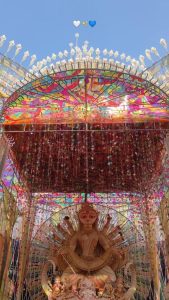 both familiar and spiritually magnifying. The arrangement was praised for its calming presence, a stark and welcome contrast to the sensory overload of themed pandals.
both familiar and spiritually magnifying. The arrangement was praised for its calming presence, a stark and welcome contrast to the sensory overload of themed pandals.
Social media and forums echoed lines like:
“It felt like I was inside my childhood courtyard, with every detail whispering home.”
“Elegant, unhurried, and deeply human in its design.”
Such comments reflected the emotional resonance of the courtyard theme.
Sustainability and Community Engagement
In line with their thematic ethos, Tridhara Sammilani maintained a strong commitment to community values:
-
The pandal predominantly used eco-friendly materials—bamboo framework, recycled cloth, clay embellishments—aligning with sustainable artistry.
-
Many of the decorative elements were hand-drawn by local youth and artisans, ensuring tradition passed through active community collaboration.
-
Food stalls and ornamental kiosks were managed by local micro-entrepreneurs, blending festival exuberance with economic inclusivity.
Reflection: Why Prangan Mattered in 2024
As an artistic expression, Tridhara’s Prangan earned its acclaim through its relational depth—it wasn’t about scale, but about soul.
-
The powerful interplay of memories, culture, and modern relevance set its creative tone.
-
Its intimate, calm ambience offered respite in a festival known for its sensory intensity.
-
It reintroduced the concept that spirituality thrives in simplicity, not shimmer.
Plan Your Visit: Immersing in the Courtyard Experience
If you’re planning to experience Prangan at Deshapriya Park:
-
Visit early morning (7–9 AM) for quiet introspection during rituals.
-
Evenings (6–9 PM) bring the courtyard to life under soft lights—ideal for immersive photography.
-
Seminar sessions and art stalls often operate midday—perfect for interactive cultural experiences.
-
Respect the subdued atmosphere—soft conversations and appreciative silence complement the theme.
Final Thoughts: A Courtyard of Memories
Tridhara Sammilani’s Durga Puja 2024 wasn’t just a celebration—it was a cultural embrace. Through Prangan, the club offered a visual and emotional refrain: a reminder of where we come from, how tradition forms our identity, and how the divine lives in familiar, everyday spaces.
In the chaos and color of Durga Puja, Prangan stood as a quiet sanctuary. And therein lay its beauty—reminding Kolkata that the deepest traditions reside not only in grand spectacle, but in warm, welcoming courtyards where faith, art, and memory meet.

